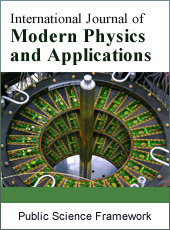International Journal of Modern Physics and Applications
Articles Information
International Journal of Modern Physics and Applications, Vol.1, No.4, Sep. 2015, Pub. Date: Jul. 20, 2015
Analysis of Molecular Dynamic Simulations Using Wavelet-Based Techniques
Pages: 145-151 Views: 5054 Downloads: 1540
[01]
A. Abdel-Hafiez, Experimental nuclear physics Department, Nuclear research center, AEA, Cairo, Egypt.
In this paper, I focus on describe, calculate and analyze of molecular dynamic(MD) simulations using wavelet transform (WT) techniques by analogy with its use in signal and image processing, so that I would like to talk about the theoretical background wavelet transform methods, including what properties they have, their common types, and how to operate them. Secondly, I would introduce the continuous wavelet transform, which is especially well-suited for time course data such as molecular dynamics simulations. , the WT permits filtering out the high-frequency noise without completely omitting the high-frequency phenomena whose contribution is crucial in cases where the dynamics is localized in frequency and time. Medical applications could be studied in which biomedical related research requires lots of mathematical and engineering techniques to analyze data. The WT is observed to excel in reconstructing the original signal by a subset of the basis used in the analysis and in identifying the occurrence of rare phenomena by examining the wavelet energies at high-resolution levels.
Molecular Dynamics, Wavelet Techniques, Some Applications
[01]
R.X. Gao, R. Yan, Wavelets: Theory and Applications for Manufacturing, Springer, 2010
[02]
M. Akay et al. Time Frequency and Wavelets in Biomedical Signal Processing, Wiley-IEEE Press, 1997
[03]
L. Cohen, "Time-frequency distributions-A review," Proc. IEEE, vol. 77, pp.941-981, 1989.
[04]
L. Cohen, Time-Frequency Signal Analysis. Englewood Cliffs, NJ: Prentice Hall, 1995.
[05]
T.C.M. Claasen and W.F.G. Mecklenbrauker, "The Wigner distribution-A tool for time-frequency signal analysis-Part I: Continuous-time signals," Philips J. Res., vol. 35, pp. 217-250, 1980.
[06]
T.C.M. Claasen and W.F.G. Mecklenbrauker, "The Wigner distribution-A tool for time-frequency signal analysis-Part II: Discrete time signals," Philips J. Res., vol. 35, pp. 276-300, 1980.
[07]
A. Nayak, R.J. Roy, and A. Sharma,"Time-frequency spectral representation of the EEG as an aid in the detection of depth of anesthesia," Ann. Biomed. Eng., vol. 22, pp. 501-513,1994.
[08]
T. C.M. Claasen and W.F.G. Mecklenbrauker, "The Wigner distribution-A tool for time-frequency signal analysis-Part III: Relations with other time-frequency signal transformations," Philips J. Res., vol. 35, pp. 372-389, 1980.
[09]
W. J. Williams and T. H. Sang, "Adaptive RID kernels which minimize time-frequency uncertainty," IEEE Int. SY111p. Time-Frequency and Time-Scale Analysis, pp. 96-99, 1994.
[10]
W.J. Williams, "Time-frequency analysis of biological signals," IEEE Int. Conf. Acoust. Speech, Signal Proc., vol. I, pp. 83-~6, 1993.
[11]
C.S. Zheng, W.J. Williams, and J.C. Sackellares, "RID time-frequency analysis of median filters and lowpass filters in reducing EMG artifacts in EEGrecording," Proc. IEEE Int. Con. Eng. Med. Bioi., vol. 15, pt. I, pp. 350-351,1993.
[12]
Beck DAC, Jonsson AL, Schaeffer RD, Scott KA, Day R, Toofanny RD, Alonso DO, Daggett V. Dynameomics: mass annotation of protein dynamics and unfolding in water by high-throughput atomistic molecular dynamics simulations. Protein: Engineering, Design and Selection. 2008; 21:353.
[13]
van der Kamp MW, Schaeffer RD, Jonsson AL, Scouras AD, Simms AM, Toofanny RD, Benson NC, Anderson PC, Merkley ED, Rysavy S, Bromley D, Beck DAC, Daggett V. Dynameomics: a comprehensive database of protein dynamics. Structure. 2010; 18(4):423. [PubMed: 20399180]
[14]
Shaw, DE.; Dror, RO.; Salmon, JK.; Grossman, JP.; Mackenzie, KM.; Bank, JA.; Young, C.; Deneroff, MM.; Batson, B.; Bowers, KJ.; Chow, E.; Eastwood, MP.; Ierardi, DJ.; Klepeis, JL.; Kuskin, JS.; Larson, RH.; Lindorff-Larsen, K.; Maragakis, P.; Moraes, MA.; Piana, S.; Shan, Y.; Towles, B. Proceedings of the Conference on High Performance Computing, Networking, Storage and Analysis (SC09). New York, NY, USA: Association of Computing Machinery; 2009. Millisecond-Scale molecular dynamics simulations on Anton.
[15]
Dror RO, Jensen M, Borhani DW, Shaw DE. Exploring atomic resolution physiology on a femtosecond to millisecond timescale using molecular dynamics simulations. Journal of General Physiology. 2010; 135:555. [PubMed: 20513757]
[16]
Miao L, Schulton K. Probing a structural model of the nuclear pore complex channel through molecular dynamics. Biophysical Journal. 2010; 98:1658. [PubMed: 20409487]
[17]
Lindahl E, Samsom MSP. Membrane proteins: molecular dynamics. Current Opinions in Structural Biology. 2008; 18:425.
[18]
Day R, Daggett V. All-atom simulations of protein folding and unfolding. Advances in Protein Chemistry. 2003; 66:373. [PubMed: 14631823]
[19]
Stephane Mallat. A Wavelet Tour Of Signal Processing. Academic Press, 1998.
[20]
Stephane Mallat and Sifen Zhong. Characterization of signals from multiscale edges. IEEE TRANSACTION ON PATTERN ANALYSIS AND MACHINE INTELLIGENCE, 14(7):23, July 1992.
[21]
Mauro Barni. Document and Image Compression. CRS Press, Taylor and Francis Group, 2006.
[22]
Kehl C, Simms AM, Toofanny RD, Daggett V, Fersht A. Dynameomics: a multi-dimensional analysis-optimized database for dynamic protein data. Protein: Design, Engineering, and Selection. 2008; 21:379.
[23]
Simms AM, Toofanny RD, Kehl C, Benson NC, Daggett V. Dynameomics: design of a computational lab workflow and scientific data repository for protein simulations. Protein: Design, Engineering, and Selection. 2008; 21:369.

ISSN Print: 2381-6945
ISSN Online: 2381-6953
Current Issue:
Vol. 7, Issue 1, March Submit a Manuscript Join Editorial Board Join Reviewer Team
ISSN Online: 2381-6953
Current Issue:
Vol. 7, Issue 1, March Submit a Manuscript Join Editorial Board Join Reviewer Team
| About This Journal |
| All Issues |
| Open Access |
| Indexing |
| Payment Information |
| Author Guidelines |
| Review Process |
| Publication Ethics |
| Editorial Board |
| Peer Reviewers |


